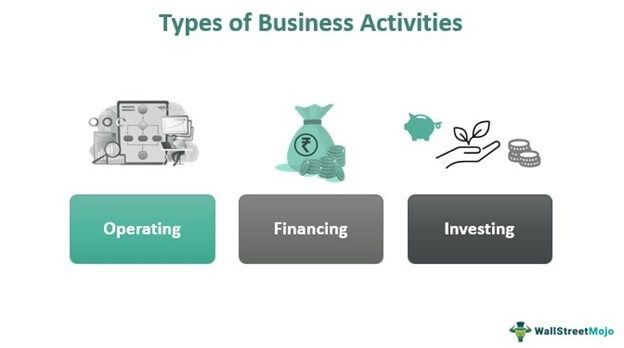Table Of Contents
Business Activities Meaning
Business activities refer to the activities performed by businesses to make a profit and ensure business continuity. Examples include production, sales, purchase of property, plant, and equipment, acquisition of other companies, purchasing marketable securities, and obtaining loans from financial institutions.

Proper conduct and management of business undertakings play an important role in generating adequate cash flow and stakeholder satisfaction. It, in turn, helps businesses to sustain its life and grow. Hence, activities efficiency indicates an entity's conformity with the going concern concept.
Key Takeaways
- Business activities refer to all kinds of activities firms conduct to achieve their purpose. It generates revenue and ensures business continuity.
- Examples include production, marketing, and sales.
- The three types of activities are operating, investing, and financing activities.
- Operating activities are the core activities performed by an entity daily, supporting the entity's primary purpose.
- Financing activities are associated with collecting funds for financial strength and business growth.
- Finally, investing activities occur when the entity invests in long-term assets.
Business Activities Explained
Business activities are the core of every organization. After incorporation of the firm or starting a business and being idle will not create revenue. It will remain as a cost-incurring node. It's the function of input and activities that generates revenue. Hence the collection of day-to-day operations, financing, and investing activities powers the entity to run efficiently and generate revenue.
The activities performed by entities vary based on factors like industry and size of the entity, and type of entity structure followed. For example, a service company will not have manufacturing activities. Also, comparing e-business and traditional brick and mortar business models draws attention to the difference in their logistics functions.
The nature and complexity of activities vary between small and large entities. Small businesses can do more with fewer resources. For example, small entities can survive without events like human resource activities and technology utilization, unlike large organizations that spend heavily on human resource management and technologies. Nowadays, large organizations may use business activity monitoring software's to collect information about various operations and processes of the entity to make better business decisions.
Types of Business Activities
Different activities in an entity are segregated into different types primarily based on their nature. The three main types of business activities are operating, financing, and investing activities. The prime purpose of these classifications comes into highlight while preparing the cash flow statements of a business. It helps to identify which activities are causing more cash outflows or inflows.
#1 - Operating
Operating activities refer to the core activities performed by an entity daily like production, sales, and marketing. Operating activities are inherent to every entity. It helps produce goods and services to the target market to achieve the desired result. These activities cause cash outflows, and its successful conduct contributes significantly to the cash inflows.
One of the main sources of operating activities is administrative units like accounting and human resources. Similarly, other departments like manufacturing, marketing, and sales department entail various operating activities. Examples of the operating activities section of a cash flow statement generally include cash flows associated with accounts receivables, accounts payables, interest payment, taxes, cash from customers, cash paid to suppliers, etc.
#2 - Investing
Investing activities originate when an entity engages in tasks like purchasing and selling property, plant, and equipment. The investment activities section in the cash flow statement portrays the cash inflow and outflow during a specific period when the company engages in investments.
Cash outflow commonly occurs due to investing in fixed assets, and inflows are obtained from the sale of fixed assets. For example, the investing section of the cash flow statement contains cash flows associated with proceeds from the sale of PPE (property, plant, and equipment) and purchase of property plant and equipment.
#3 - Financing
Financing activities are associated with collecting funds for a firm's growth and attaining financial strength. They may use the fund for investing in long-term projects and support daily operations. It portrays cash flow between the business, its investors, and creditors. As a result, an entity's financing activities throw light into its capital structure: the proportion of equity and debt used.
The activities include collecting long-term funds and settling the long-term liabilities or other obligations. The financing activities section of the cash flow statement comprises dividend payment, proceeds from stock and debt issuance, repayment of long-term loans and purchase of treasury stocks, etc.

